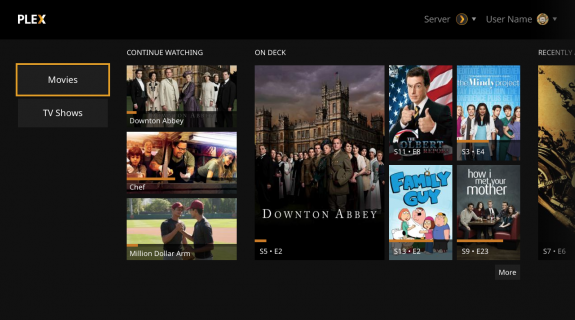The winners of the war in digital content delivery will be those who make the most watchable and most available content. This is an industry-shaking development so preoccupying it’s easy to forget that sometimes that content is already readily available to the viewer—because the viewer loves it so much they already own it.
But even watching the media we actually own can get complicated, as external hard drives, cloud-based companies like Dropbox and Google Drive, and other storage services have “kind of scattered it to the wind, so we tend to forget about it,” said Scott Hancock, CMO of the media organizing and consuming app Plex.
Plex pulls all of the media in your collection, whether video, music, photos or other, from all the different outlets it may reside in, and funnels it into one easily navigable interface. From there, the files can be accessed and consumed across any connected device, be it mobile, desktop or smart TV. The presentation is elegant, and all the accompanying artwork, descriptions, ratings and other accoutrements come along for the ride.
“It’s that one window into all your media, no matter where you are,” Hancock said. “We want Plex to be consistent across all your screens, whether you’re on an Android or an iPad or an Amazon Fire TV, or any streaming device… We want to ignore the file structure and put the media front and center.”

Plex has cultivated an ardent following of digitally minded music buffs, TV lovers and other media hoarders since its inception in the late 2000s, who oftentimes paid for its premium subscription service (the Plex Pass), said Hancock, “almost as a donation to make sure we’d stay in business.” Word of mouth was scant because those who weren’t technologically savvy struggled with the service, and its converts found themselves serving as “tech support” to those they shared it with, he continued. Now, however, “we’re casting a wider net,” Hancock said.
Setting up the service, which involves downloading the Plex Media Server to a host computer then directing it toward the various locations where your media might reside, has become relatively streamlined, and the number of users has grown to nearly 5 million globally.
Those aren’t yet the kind of numbers that would hook the interest of a major broadcast or streaming partner, said Hancock, but they might be someday.
“We want to be that one window and if we ever get to that point where we have enough volume – you never know. It could make sense for a [streaming company] to offer up a channel on our system. In the meantime, Plex users can supplement their own media with select online offerings from the likes of Comedy Central, PBS, Lifetime, Twitch and Yahoo Screen. “That’s an area we’re going to be focusing more on,” said Hancock. “As we get more and more eyeballs we’ll be able to get more of those premium content partners.”
In essence, Hancock said, Plex is “flipping the cable model on its head. Cable used to be that one window into what you want to watch,” and that window was and is a murky one. The content you want is probably buried in those hundreds of channels and time slots somewhere, but it’s up to you to find it. Plex starts at the reverse end, organizing only the media you want – indeed, you care so much about it, you’ve added it to your personal collection – then “augmenting it with things you might want,” said Hancock.
Whatever those things include, Plex is advancing its revolutionary organizational system, working its way from the individual out, instead of vice versa.
Tags:













































__twocolumncontent.jpg)











